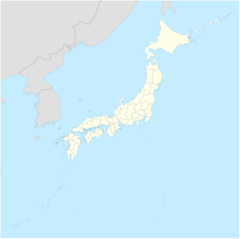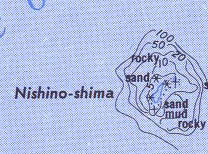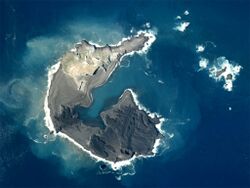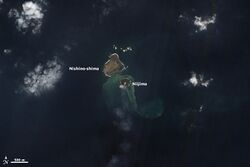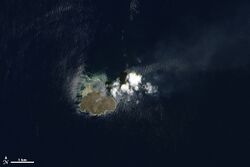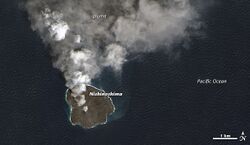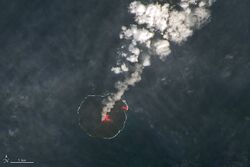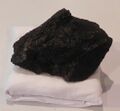Earth:Nishinoshima (Ogasawara)
| Native name: 西之島 | |
|---|---|
 Nishinoshima on 1 December 2018 | |
| Geography | |
| Location | Pacific Ocean |
| Coordinates | [ ⚑ ] : 27°14′49″N 140°52′28″E / 27.24694°N 140.87444°E |
| Archipelago | Volcano Islands |
| Total islands | 1 |
| Area | 4.1[1] km2 (1.6 sq mi) |
| Highest elevation | 200 m (700 ft) |
| Administration | |
| Prefecture | Tokyo |
| Subprefecture | Ogasawara Subprefecture |
| Village | Ogasawara |
| Demographics | |
| Population | 0 |
Nishi-no-shima (Japanese: 西之島, "western island") is a volcanic island located around 940 km (584 mi) south-southeast of Tokyo,[2] that is part of the Volcano Islands arc. Nishinoshima is located about 130 km to the west of the nearest of the Ogasawara islands, hence the name, but the other Ogasawara island groups are aligned north-south. The nearest of the other Volcano islands is over 270 km away, but Nishinoshima is on the alignment of the Volcano islands.
Originally the above-water part of the ridge of an underwater caldera, Nishinoshima was enlarged in 1974 after fresh eruptions created a new section of the island. Another eruption that began in November 2013 further enlarged the island and attracted worldwide attention.[3][4][5] A volcanic cone soon formed, rising to an estimated height of 142 m (466 ft) by July 2016.[2][6] The eruptions ceased by November 2015, though emissions of volcanic gases continued for several months afterwards.
As of 2016, the island was about 2.7 km2 (1.0 sq mi) in size and showed evidence of the return of various plants and animal species.[7]
There were further eruptions in 2017,[8] 2018, and in 2019–2020.[9] As of 14 August 2020, it is about 4.1 km2 (1.6 sq mi) and over 2 km (1.2 mi) in diameter.[1]
Etymology
The island was named "Rosario Island" when it was discovered by the Spanish ship Rosario in 1702.[10] That was the island's name until 1904 when the Japanese term "Nishinoshima" (literally, "West Island") was made the official name.[11]
When a new island was formed in the 1973 eruption, that was called Nishinoshima Shintō (西之島新島, literally, "New Nishinoshima Island"), but due to erosion and shifting sands, that island joined the main island and ceased to be considered a separate entity.[11]
During the early stages of the 2013 eruption, a new volcanic island was formed southeast of the original Nishinoshima. The island was not given an official name but was mentioned in Japanese reports as "new island": atarashii shima (新しい島) or shintō (新島).[12] Government officials said the island would be named "after it is stable and it is clear it will remain".[13] As the island has now merged with Nishinoshima, "there is little possibility it will be named as a separate entity."[14]
Geology
Morphology
Prior to 1974, Nishinoshima was a small, green island which had no eruptions in the past 10,000 years. The island was merely the tip of an undersea volcano some 3,000 m (9,800 ft) in height and 30 km (19 mi) wide at the base.[15] Its main period of activity was from the Late Pleistocene to the Holocene.[16] The volcano takes the form of a caldera, with the original Nishinoshima and some nearby rocks forming part of the northwest ridge of a caldera about 1 km (0.6 mi) in diameter.[17] The island was originally about 650 m (710 yd) long and 200 m (220 yd) wide.[11] A 1911 survey determined the caldera was 107 m (351 ft) at its deepest.[15] The volcano has many large, submarine, satellite cones to the south, west, and northeast. The southern cone rises to within 196 m (643 ft) of the surface, around 9 km (6 mi) SSE of Nishinoshima.[15]
1973–1974 Eruption
On 30 May 1973, the crew of a passing ship noted that, at around 11:00, white smoke rose east of the island to around 100 m (330 ft) in the air every few minutes. An aerial inspection the next day said that the eruption was taking place 400 m (440 yd) east of the island. A whirlpool was also seen. Yellow-green sea water and floating pumice were seen 5 km (3 mi) north of the site. Another crew discovered that two black rocks were rising from the sea.[citation needed]
In July, the eruption continued to erupt water fountains every few minutes with white smoke rising to 100 m above sea level. An aerial inspection on 14 September noted that a new island had formed above the submarine eruption site, the island formed a cinder cone around 40 m (130 ft) high and 120 m (130 yd) across. The new island had a 70 m (77 yd) diameter crater that frequently ejected cinders to a maximum height of 300 m (980 ft). White smoke rose to a height around 1,500 m (4,900 ft) high.[citation needed]
In November, a fissure eruption was noted on the new island with a chain of cinder cones running from southwest to northeast. The most recent cones were formed at the end of the chain, with the original cone being destroyed by the waves. The cones were erupting ash to a height of around 300 m (980 ft).
In December, the new island grew larger than "old" Nishinoshima. The island was 700 m (770 yd) long and 250 m (270 yd) wide; the new island had now developed a central crater that rose to a maximum height of 40 m (130 ft). The cone was continuing to eject ash and cinders to a height of 100 m (330 ft). A small craterlet on the new island was also emitting lava flows.[citation needed]
By February 1974, the new island had developed two cinder cones at the western end of the new island, but only the eastern cinder cone was erupting. Observations on 11 January noted that the active eastern cinder cone was emitting a lava flow.[citation needed]
In March, the new island was still erupting; by then, the island had five cinder cones; one cinder cone was erupting red hot lava. Lava flows were still erupting from the new island's flanks. On 1 March, the five cinder cones were quiet, but a large lava flow may have still been effusing from the island's flanks. After that, the eruption ended; wave movements then joined the new and old islands.[citation needed]
2013–2015 eruption
In November 2013, an eruption created a new small island south-southeast off the shore of the original island.[4][5][18][19] By December 2013, the island rose 20–25 m (66–82 ft) above sea level, with an area of 56,000 square meters (13.8 acres). The island was considered large enough to maintain a presence above sea level for at least several years.[20][21] By 20 December 2013, the island had grown fast enough that experts predicted that it would probably join up with Nishinoshima before the end of 2013 and cease to be a separate island.[22] On 26 December 2013, the Japanese Coast Guard confirmed that the two islands had joined.[23]
NASA says two cones have formed around the main volcanic vents and stand more than 60 m (200 ft) above sea level.[3] The newer portion of the island is now larger than the original Nishinoshima landmass. The merged island is slightly more than 1 km (0.6 mi) across.
During July and August 2014, lava flow increased, causing the island to expand rapidly to the east. Between September and December, the lava flow increased further and headed north, almost completely overrunning the pre-existing island, leaving only a small portion of the old island exposed.[24] On 27 December 2014, Japanese authorities said the island had reached nearly 2.3 km2 (570 acres) in size and is estimated to have risen to about 110 m (360 ft) above the sea level and that the volcano was still active.[6] A pyroclastic cone formed around the vents which further rose the island to about 135 m (442 ft) by 23 February 2015.[2][25]
The eruption continued throughout the first half of 2015, and the island continued to expand. However, by August, the volcano ceased to erupt smoke and ash, but continued to emit lava.[26] As of 16 September 2015, the total area of the island had decreased slightly, but the fumarolic zone had expanded as "vigorous volcanic activity continued without significant change".[27] Eruptions resumed soon thereafter,[28] but 17 November 2015, was the date of the last observed explosive eruption.[29] Fumarolic activity continued, but decreased in amount as no new lava flows were observed.[29] Decreases in temperatures were also recorded, and subsidence was observed near the summit of the volcano.[29] In August 2016, the Japan Meteorological Agency announced that the alert level for the volcano had been lowered, and that the no-entry zone had been reduced from a radius of 2 km (1.2 mi) to a radius of 500 m (1,600 ft).[29][30] This would finally enable landings on the island. Water discoloration was still evident immediately offshore in August, indicating that volcanic activity, while in significant decline, was still present.[31] On 14 February 2017, the Japan Meteorological Agency cancelled all alerts for the island, declaring that there was no indication of subsequent eruptions.[32]
In October 2016, a team of scientists visited Nishinoshima to conduct research on the island.[7][33] Apart from documenting the island's ecology and geology, monitoring equipment was also installed for future volcanic activity.[34]
Wyss Yim, a retired professor of Earth Sciences, has theorised that the Nishinoshima eruption caused the North Pacific Blob, a mass of warm surficial water off the Pacific Coast of North America.[35][36]
2017 and 2018 eruptions
On 20 April 2017, the Japan Coast Guard confirmed explosive eruptions at the No. 7 crater at Nishinoshima and lava flows emerging from the base of volcano. Satellite imagery from 19 April also confirmed high temperatures on the island.[37] Examination of the data revealed that the eruption likely began on 17 April.[38] By 27 April, two lava flows had reached the sea, one on the west shore, the other on the south-west shore of the island.[39] By 29 June, the flows had created two lobes, one extending 330 meters beyond the western shore, and other 310 to the south-west. The area of the island increased to 2.9 km2 (1.1 sq mi).[40] By July, surface temperatures began to decrease until they became indistinguishable from the surroundings in August; lava flows also stopped by the end of August.[38] On 3 October, the Coordinating Committee for Prediction of Volcanic Eruptions of the Japan Meteorological Agency announced that Nishinoshima had likely ceased erupting.[38] In June 2018, the JMA announced that the no-entry zone had been reduced from a radius of 2 km (1.2 mi) to a radius of 500 m (1,600 ft).[41] Within a month, however, the zone was returned to 1,500 m (4,900 ft) after small eruptions were spotted on 12 July 2018.[42] These eruptions quickly subsided, and the no-entry zone was reduced back to 500 m on 31 October 2018.[43]
2019–2020 eruption
On 6 December 2019, the Japan Coast Guard confirmed explosive activity in Nishinoshima has returned, with new lava flows entering the sea by the following day.[6] The conditions were enough that the Meteorological Agency issued a warning to passing ships to stay clear of Nishinoshima.[44]
In January 2020, the Japan Coast Guard observations confirmed that lava was flowing out on the northeast coast.[45] Further activity was observed on 4 February, and the northern extension of the island was expected.[46]
As of 25 June 2020, the explosive-effusive eruption was still continuing, with lava flows on the northeastern slope of the volcano, as well as ash plumes reaching 2,600 m (8,530 ft).[47] On 4 July, an ash plume reached 8,300 m (27,230 ft) in height.[48] On 14 August, it reached a size of 4.1 km2 (1.6 sq mi) with a diameter over 2 km (1.2 mi).[1]
2021 eruption
On 14 August 2021, around 6 AM, artificial satellites confirmed an eruption for the first time since late August 2020. The height of the eruption was about 1,900 m (6,230 ft).[49] On 15 August, the Japan Coast Guard made observations by aircraft, but no eruption was confirmed.[50]
2022 eruption
On 1 October 2022, satellite images confirmed that Nishinoshima had erupted again and continued to erupt until 12 October, when a Japan Coast Guard aircraft confirmed it was no longer erupting.[51]
Overall, in the decade since the latest series of eruptions began, the island increased in size by 20 times.[52]
Ecology
Since the 2013 eruption, biologists have expressed great interest in how Nishinoshima would be colonized by plants and wildlife. It is expected that organic matter, mainly deposited by nesting birds in the form of feathers or excrement, would enrich the island surface for plants to grow.[53] To prevent interference of the colonization process, researchers were also advised not to bring external species to Nishinoshima.
In October 2016, a team of scientists visited Nishinoshima to examine its environment and geologic makeup for the first time up-close.[7][33] Their studies have discovered that both plant and animal life continue to exist on the remaining part of the old Nishinoshima island that had not been covered by lava. An accompanying video crew from Nippon TV captured masked boobies laying eggs and a pod of dolphins (either Indo-Pacific, Tursiops aduncus, or common bottlenose, T. truncatus) swimming off the coast.[33] Gannets, bramblings and earwigs were also discovered living on the island by researchers.[54] Several cetaceans have been known to live around the island prior to the eruption such as spinner dolphins and short-finned pilot whales,[55] and above mentioned bottlenose dolphin. Humpback whales had been seen before the eruption,[56] and their recent returns have been confirmed as well.[57] In terms of flora, plants that were present on the original island like goosegrass and purslane were found to be growing again on the "old" section of Nishinoshima.[54]
Important Bird Area
The island and its surrounding waters has been recognised as an Important Bird Area (IBA) by BirdLife International because it supports a population of greater crested terns.[58]
See also
- Surtsey, a new volcanic island that was formed in a similar manner off Iceland in 1963–67.
- Desert island
- Lists of islands
- List of volcanoes in Japan
- List of islands in Japan
- Fukutoku-okanoba
References
- ↑ 1.0 1.1 1.2 藤波優 (2020-08-28). "西之島、なくなっちゃうかも? 噴火の方式に変化の兆し". 朝日新聞デジタル. https://www.asahi.com/articles/ASN8V6JJSN87ULBJ013.html. Retrieved 2020-09-01.
- ↑ 2.0 2.1 2.2 "Nishinoshima". Smithsonian Institution. https://volcano.si.edu/volcano.cfm?vn=284096.
- ↑ 3.0 3.1 Volcanic islands merge in Pacific Ocean BBC, 8 April 2014
- ↑ 4.0 4.1 "Volcanic Blast Forms New Island Near Japan". Universetoday.com. 2013-11-21. http://www.universetoday.com/106645/volcanic-blast-forms-new-island-near-japan/. Retrieved 2014-04-06.
- ↑ 5.0 5.1 "Volcano Eruption Creates New Island". International Business Times. 21 November 2013. http://www.ibtimes.com/volcano-eruption-creates-new-island-japanese-coast-guard-footage-shows-formation-tiny-islet-pacific. Retrieved 22 November 2013. with pictures.
- ↑ 6.0 6.1 6.2 "西之島|海域火山データベース|海上保安庁 海洋情報部". https://www1.kaiho.mlit.go.jp/GIJUTSUKOKUSAI/kaiikiDB/kaiyo18-2.htm.
- ↑ 7.0 7.1 7.2 "Japan team swims in for first up-close look at newly formed volcanic isle" (in en-US). The Japan Times Online. 2016-10-28. ISSN 0447-5763. http://www.japantimes.co.jp/news/2016/10/28/national/japan-team-swims-first-close-look-newly-formed-volcanic-isle/.
- ↑ "Nishinoshima island south of Tokyo erupts, lava heads to sea" (in en-us). http://www.asahi.com/ajw/articles/AJ201704210043.html. Retrieved 23 April 2017.
- ↑ "Nishinoshima: Eruptive History". Smithsonian Institution. https://volcano.si.edu/volcano.cfm?vn=284096.
- ↑ Freeman, Otis W. (1951). Geography of the Pacific,. pp. 229–235. ISBN 9780598436061. https://books.google.com/books?id=kjIhAAAAMAAJ.
- ↑ 11.0 11.1 11.2 "Nishinoshima". Kotobank. Asahi Shinbun. http://kotobank.jp/word/%E8%A5%BF%E4%B9%8B%E5%B3%B6. Retrieved 18 February 2014.
- ↑ "しんとう". Hokkaidō Shinbun. 12 January 2014. http://www.hokkaido-np.co.jp/news/fourseasons/514834.html. Retrieved 16 January 2014.
- ↑ "名もなき新島、どんな運命 残れば領海わずかに拡大? 小笠原諸島". Asashi Shimbun. 26 November 2013. http://www.asahi.com/shimbun/nie/kiji/20131129/.
- ↑ "Lava flow connects new islet with Nishinoshima island". Asahi Shimbun. 26 December 2013. http://ajw.asahi.com/article/behind_news/social_affairs/AJ201312260070. Retrieved 27 December 2013.
- ↑ 15.0 15.1 15.2 Nakano, Shun. "Kaitei chikei" (in Japanese). Nishinoshima Kazan. Geological Survey of Japan. https://gbank.gsj.jp/volcano/Act_Vol/nishinoshima/page3.html. Retrieved 17 February 2014.
- ↑ "Nishinoshima". Geological Survey of Japan. https://gbank.gsj.jp/volcano/Quat_Vol/volcano_data/G22.html. Retrieved 17 February 2014.
- ↑ Nakano, Shun. "Gaiyō" (in Japanese). Nishinoshima Kazan. Geological Survey of Japan. https://gbank.gsj.jp/volcano/Act_Vol/nishinoshima/index.html. Retrieved 17 February 2014.
- ↑ "Volcano raises new island far south of Japan". Times of India. 21 November 2013. http://timesofindia.indiatimes.com/world/rest-of-world/Volcano-raises-new-island-far-south-of-Japan/articleshow/26131517.cms. Retrieved 21 November 2013.
- ↑ Netburn, Deborah (19 December 2013). "Is Niijima here to stay? New image of the newest island on Earth". Los Angeles Times. https://www.latimes.com/science/sciencenow/la-sci-sn-newest-island-on-earth-20131218,0,611641.story. Retrieved 2013-12-20.
- ↑ "New volcanic island off Japan still growing in ongoing eruptions". UPI.com. http://www.upi.com/Science_News/2013/12/19/New-volcanic-island-off-Japan-could-be-permanent-scientists-say/UPI-17591387498178/?spt=rln&or=1. Retrieved 2013-12-20.
- ↑ "Japan's newly created island is actually growing". Salon.com. 19 December 2013. http://www.salon.com/2013/12/18/japans_newly_created_island_is_actually_growing/. Retrieved 2013-12-20.
- ↑ (in Japanese)47News. http://www.47news.jp/CN/201312/CN2013122001002864.html. Retrieved 20 December 2013.
- ↑ "Error: no
|title=specified when using {{Cite web}}" (in Japanese). Jiji.com. Jiji Tsūshinsha. http://www.jiji.com/jc/c?g=soc&k=2013122600471. Retrieved 26 December 2013. - ↑ "Nishinoshima coastlines". http://www1.kaiho.mlit.go.jp/GIJUTSUKOKUSAI/kaiikiDB/2013nishinoshima/nishinoshima_coastlines141225.png.
- ↑ "Nishinoshima". http://www1.kaiho.mlit.go.jp/GIJUTSUKOKUSAI/kaiikiDB/kaiyo18-e1.htm.
- ↑ "Volcanic activity". http://www1.kaiho.mlit.go.jp/GIJUTSUKOKUSAI/kaiikiDB/kaiyo18-e1.htm#list.
- ↑ "⻄之島の火山活動の状況(9月16日観測)" (in Japanese). Japan Coast Guard. http://www1.kaiho.mlit.go.jp/KIKAKU/press/2015/H270916_nisinosima.pdf. Retrieved 18 September 2015.
- ↑ "全国月間火山概況(平成27年10月)" (in Japanese). Japan Meteorological Agency. http://www.jma.go.jp/jma/press/1511/10b/1510vol-japan.pdf. Retrieved 16 December 2016.
- ↑ 29.0 29.1 29.2 29.3 "西之島の火山活動解説資料" (in Japanese). Japan Meteorological Agency. http://www.data.jma.go.jp/svd/vois/data/tokyo/STOCK/monthly_v-act_doc/tokyo/16m08/20160817_326.pdf. Retrieved 16 December 2016.
- ↑ "西之島 警報レベル引き下げ 警戒範囲は500mに縮小 3年ぶり". http://www.hazardlab.jp/know/topics/detail/1/6/16311.html. Retrieved 16 December 2016.
- ↑ "西之島 の火山活動の状況(8月18日観測)" (in Japanese). Japan Coast Guard. http://www1.kaiho.mlit.go.jp/KIKAKU/press/2016/20160824.pdf. Retrieved 16 December 2016.
- ↑ "西之島の警報解除=上陸ルール、徹底呼び掛け:時事ドットコム" (in ja-JP). http://www.jiji.com/jc/article?k=2017021401178&g=soc. Retrieved 21 April 2017.
- ↑ 33.0 33.1 33.2 earthsky102 (2016-11-14), First Visit to Nishinoshima Volcano Island, South Japan #西之島, https://www.youtube.com/watch?v=3WktAwJXX_k, retrieved 2016-12-15
- ↑ "Island volcano monitoring system tested at Nishinoshima". http://phys.org/news/2016-12-island-volcano-nishinoshima.html.
- ↑ Wyss Yim - Explanation for the north Pacific Blob. Imperial Engineer Autumn 2016, p. 15
- ↑ Wyss Yim - Geothermal heat: an episodic heat source in oceans. Imperial Engineer Spring 2017, p. 14-15.
- ↑ "西之島 活動再開の可能性?気象庁の警報解除からわずか2ヵ月 | ハザードラボ" (in ja). http://www.hazardlab.jp/know/topics/detail/1/9/19902.html. Retrieved 21 April 2017.
- ↑ 38.0 38.1 38.2 "西之島は再び「お休みモード」へ 地表の熱が低下 噴火予知連 | ハザードラボ" (in ja). Earth Scientific. http://www.hazardlab.jp/know/topics/detail/2/2/22217.html. Retrieved 4 October 2017.
- ↑ "西之島 溶岩流が海に到達!「マグマ上昇で激しい噴火のおそれ」海保 | ハザードラボ" (in ja). http://www.hazardlab.jp/know/topics/detail/2/0/20017.html. Retrieved 30 April 2017.
- ↑ "西之島 活動再開で東西に伸びる「30秒間隔で噴火」海保" (in ja). http://www.hazardlab.jp/know/topics/detail/2/0/20986.html. Retrieved 12 July 2017.
- ↑ "西之島の警戒が必要な範囲を1.5kmから500mに縮小しました" (in ja). Japan Meteorological Agency. http://www.jma.go.jp/jma/press/1806/20b/nishinoshima180620.html. Retrieved 20 June 2018.
- ↑ "西之島の火山活動解説資料". Japanese Meteorological Agency. http://www.data.jma.go.jp/svd/vois/data/tokyo/STOCK/monthly_v-act_doc/tokyo/18m07/201807132300_326.pdf. Retrieved 22 July 2018.
- ↑ "西之島の火山活動解説資料". Japanese Meteorological Agency. http://www.data.jma.go.jp/svd/vois/data/tokyo/STOCK/monthly_v-act_doc/tokyo/18m10/201810311800_326.pdf. Retrieved 11 June 2019.
- ↑ "Volcanic warning level raised for Nishinoshima | NHK WORLD-JAPAN News" (in en). https://www3.nhk.or.jp/nhkworld/en/news/20191216_33/.
- ↑ "西之島の噴火について(1月17日観測)". 海上保安庁. 2020-01-17. https://www.kaiho.mlit.go.jp/info/kouhou/post-715.html. Retrieved 2020-02-05.
- ↑ "拡大止まらぬ西之島「5秒毎に噴火」噴煙2700m上昇!海保が撮影(最新動画)". ハザードラボ. 2020-02-05. https://www.hazardlab.jp/know/topics/detail/3/3/33012.html. Retrieved 2020-02-05.
- ↑ "Nishino-shima volcano (Volcano Islands, Japan): elevated activity continues; strong eruptions". https://www.volcanodiscovery.com/nishino-shima/news/105827/Nishino-shima-volcano-Volcano-Islands-Japan-elevated-activity-continues-strong-eruptions.html.
- ↑ "Japanese island volcano active since June belches smoke reaching 8,300 meters". Mainichi Daily News. 4 July 2020. https://mainichi.jp/english/articles/20200704/p2a/00m/0na/007000c.
- ↑ "火山の状況に関する解説情報(西之島第1号)令和3年8月14日07時02分". 気象庁. 2021-08-14. https://www.data.jma.go.jp/svd/vois/data/tokyo/STOCK/volinfo/VK20210814070200_326.html. Retrieved 2021-08-14.
- ↑ "西之島の火山活動について(8月15 日観測)". 海上保安庁. https://www.kaiho.mlit.go.jp/info/kouhou/post-837.html. Retrieved 2021-09-19.
- ↑ "令和4年(2022 年)の西之島の火山活動 気". https://www.data.jma.go.jp/svd/vois/data/tokyo/STOCK/monthly_v-act_doc/tokyo/2022y/326_22y.pdf.
- ↑ "Nishinoshima Island 930 km south of mainland Tokyo has grown 20 times larger in 10 yrs" (in en). Mainichi Daily News. 2023-11-15. https://mainichi.jp/english/articles/20231115/p2a/00m/0sc/004000c?fbclid=IwAR0s12NGM-7dIo82atEP1eRgjEAm_60QGmXGh4nYick8H0VeOf7h_WirCbY_aem_AfrR0Mb279htNFb8v69Ea7ZUL09NtSbAH_3virAz4rjMFmlyV9-jgqGVyldu0OeJ0r4.
- ↑ "Nishinoshima: How bird poop will bring life to a mysterious new island". Washington Post. https://www.washingtonpost.com/news/morning-mix/wp/2015/05/19/nishinoshima-how-bird-poop-will-bring-life-to-a-mysterious-new-island/.
- ↑ 54.0 54.1 "First survey finds life goes on after eruptions on Nishinoshima:The Asahi Shimbun" (in en-us). The Asahi Shimbun. http://www.asahi.com/ajw/articles/AJ201610260062.html.
- ↑ Hidaka T. Kasuya T. Izawa K. Kawamichi T. 1996. The encyclopaedia of animals in Japan (2) - Mammals 2. ISBN:9784582545524 (9784582545517) (4582545521). Heibonsha
- ↑ Ogasawara Whale Watching Association. 2017. The last 硫黄三島&西之島 cruise of the second Ogasawaramaru. "Megaptera" the organa bulletin. Vol.73 and 74. ISSN: 1343 - 3091. Retrieved on 25 March 2017
- ↑ Nishinoshima New Island and whales. YouTube. Retrieved on 4 April 2017
- ↑ "Nishinoshima island". BirdLife International. 2021. http://datazone.birdlife.org/site/factsheet/nishinoshima-island-iba-japan.
External links
- Nishinoshima, Ogasawara by Geospatial Information Authority of Japan (in Japanese)
- Nishinoshima eruption observed by LANDSAT 8, Geospatial Information Authority of Japan
- Nishinoshima, hydrographic and oceanographic department of Japan Coast Guard (page in English)
- New Japanese Island Forming in Pacific Ocean: Photos, 22 November 2013
- New island at NASA's Earth Observatory website
 |
